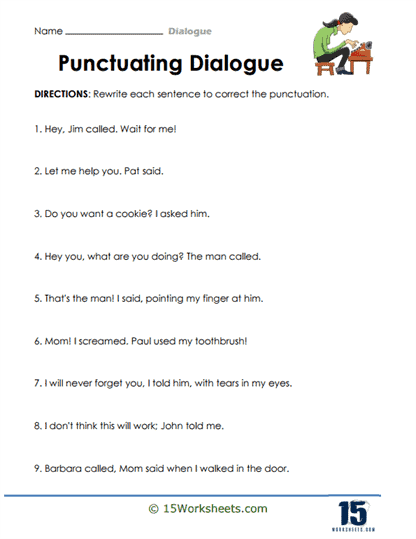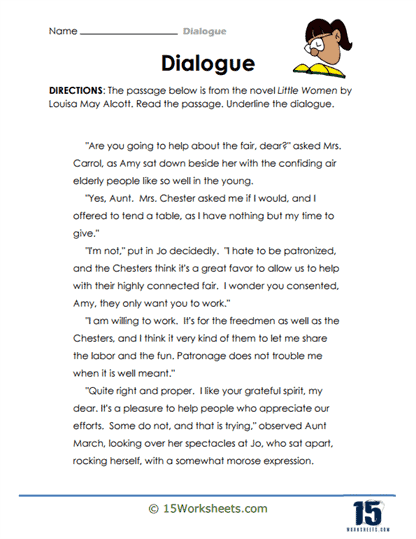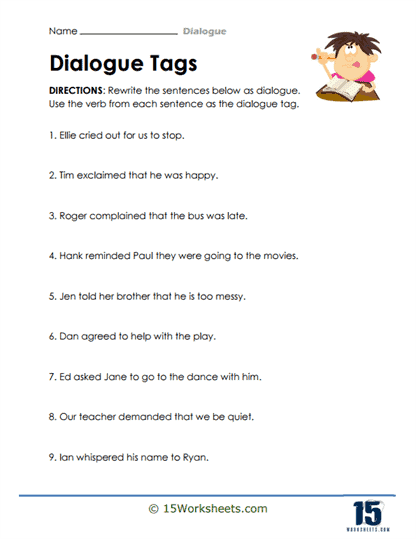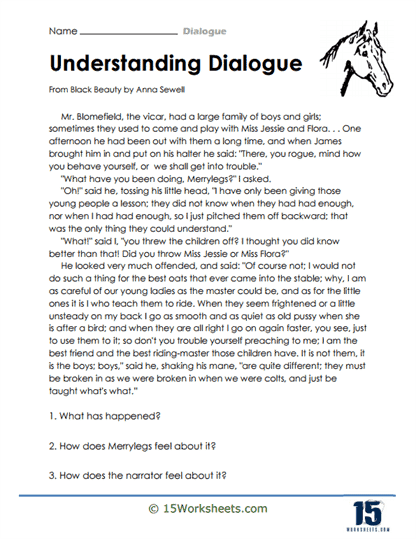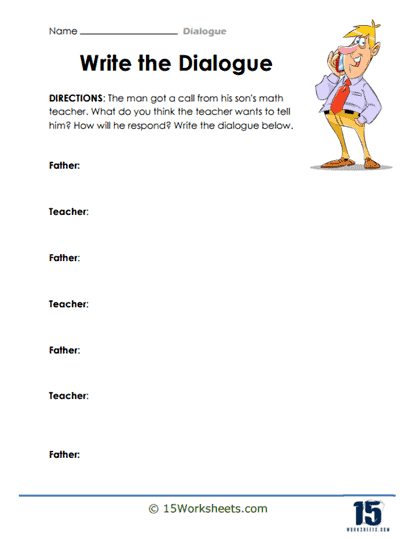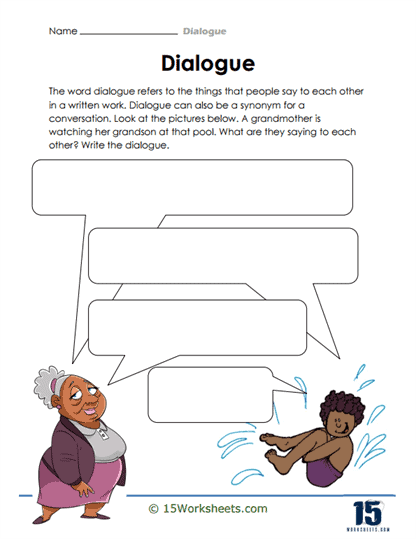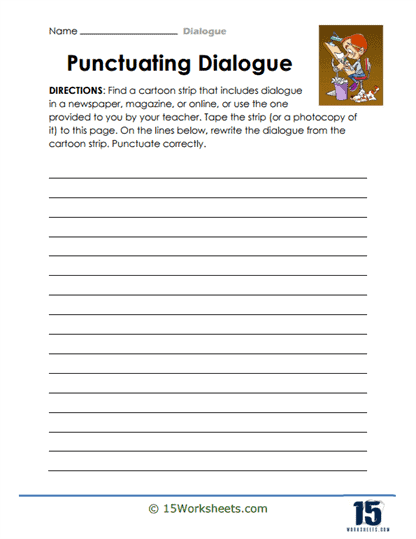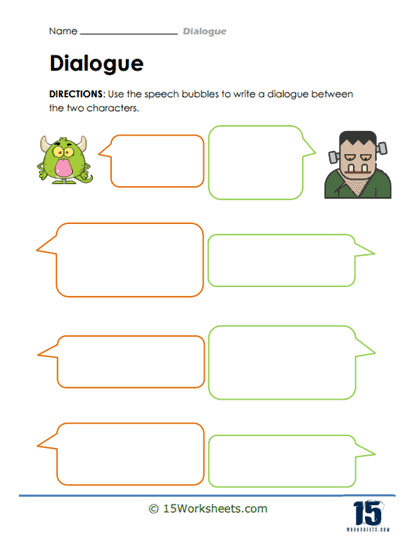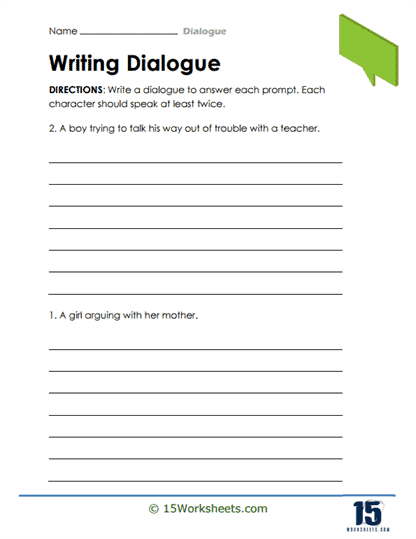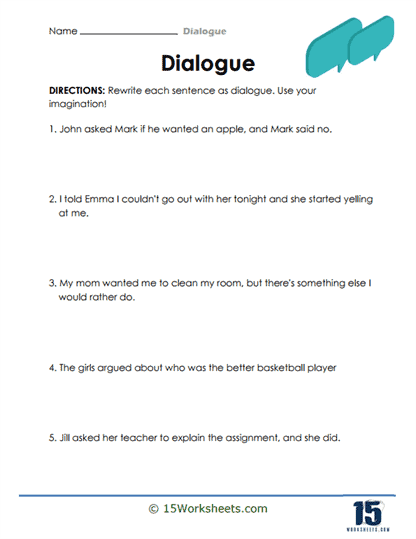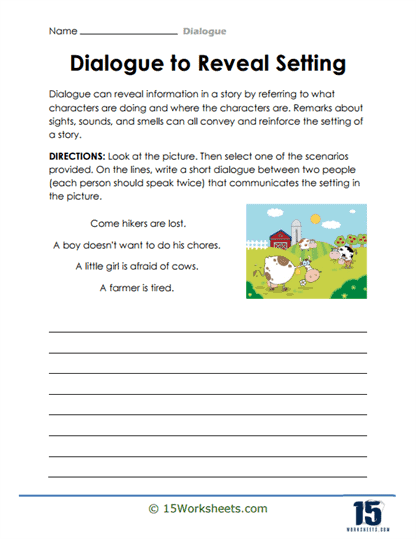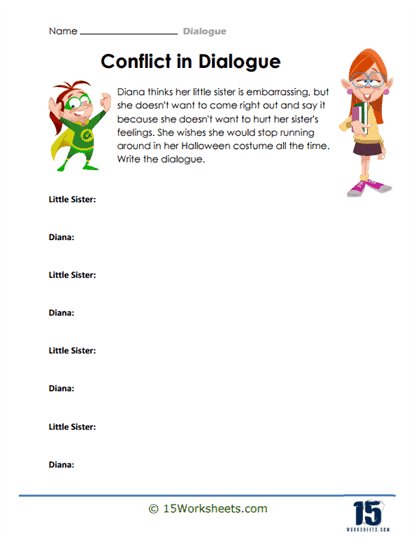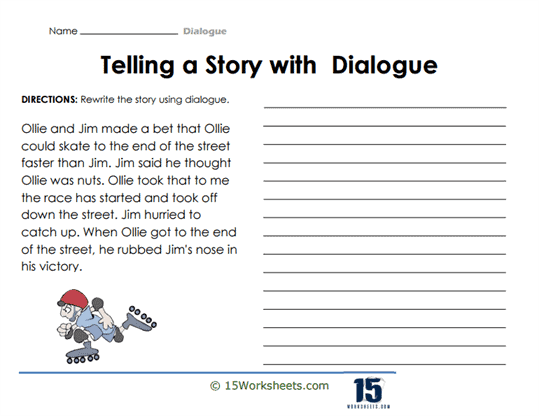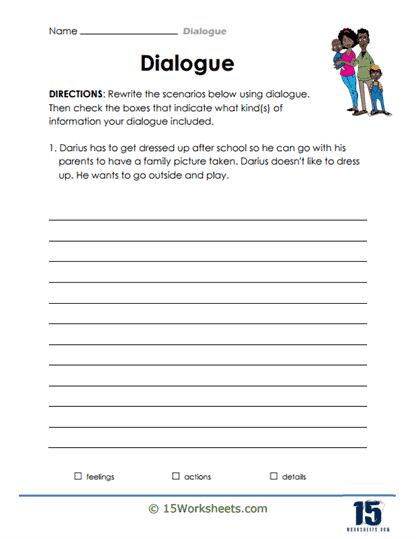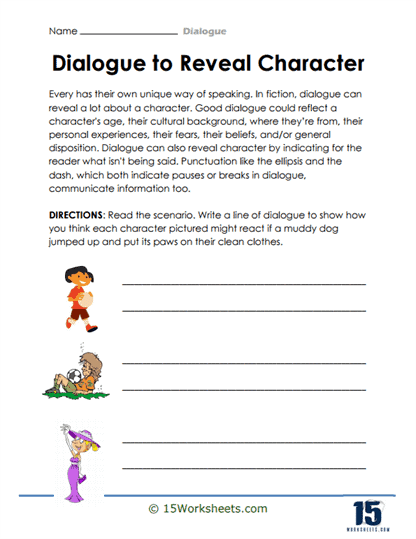Dialogue Worksheets
All About These 15 Worksheets
The collection of worksheets focuses on helping students develop their understanding and usage of dialogue in various contexts. The exercises work on essential skills like punctuation in dialogue, recognizing dialogue tags, and constructing conversations that reveal character or setting. By focusing on dialogue, students are encouraged to enhance their writing skills, specifically learning how to structure direct speech in a story. This practice is crucial in ensuring students know how to punctuate dialogue correctly and use it effectively to drive narratives.
Another key skill these worksheets emphasize is understanding character development through dialogue. The scenarios provided give students opportunities to infer character traits and intentions based on how they speak or react in different situations. Students are asked to craft responses for characters in given contexts, like how someone might react to an event, which pushes them to think critically about the character’s personality and motivations. This is instrumental in honing their ability to write realistic, engaging dialogue that reflects deeper character development in their own stories.
The worksheets focus on the technical use of dialogue to enhance plot and setting, giving students chances to explore how conversations between characters can build context and contribute to storytelling. Students must write lines for specific situations, revealing not only who the characters are but also where they are or what’s happening around them. This reinforces skills like attention to detail, creativity, and an understanding of how setting and action can be communicated through dialogue. This focus helps young writers integrate more dynamic conversations in their stories while considering their broader narrative impact.
A Look At Individual Worksheets
We tackle the technicalities of dialogue punctuation. “Punctuation Fix-Up” ensures that students learn the correct placement of quotation marks, commas, and periods, preventing their characters from sounding like robots or run-on sentences. “Sentence Makeover” takes bland sentences and transforms them into engaging dialogues, teaching students how punctuation can alter the tone and clarity of a conversation. These exercises are essential for students to avoid the dreaded “grammar police” citations in their
We delve into the realm of character voice and tone. “Uncover What’s Said” challenges students to infer the speaker’s identity and emotions based on dialogue alone, honing their analytical skills. “Verbal Shift” explores how changes in speech patterns can indicate shifts in mood or character development. “Voices From The Pages” encourages students to match dialogue to specific characters, reinforcing the importance of consistent voice. These worksheets help students understand that what a character says-and how they say it-reveals much about their personality and motivations.
We also focus on crafting realistic and engaging conversations. “Math Teacher’s Call” and “Grandmother-Grandson Talk” present everyday scenarios, prompting students to write dialogues that reflect authentic interactions. “Comical Chatter” adds a humorous twist, encouraging creativity and timing in writing jokes or lighthearted exchanges. “Green Monster Meetup” introduces fantastical elements, pushing students to maintain believability even in imaginative contexts. These activities emphasize that good dialogue should feel natural, regardless of the setting or characters involved.
Students explore how dialogue drives plot and reveals themes. “Conversational Creations” tasks students with building entire scenes around a dialogue exchange, highlighting the role of conversation in storytelling. “Dialogue-Driven Scenes” focuses on how dialogue can advance the plot or create tension. “Words That Matter” encourages students to write impactful lines that resonate with readers, teaching them the power of well-chosen words. These worksheets demonstrate that dialogue isn’t just filler-it’s a crucial tool for narrative progression and thematic depth.
We examine the emotional and psychological layers of dialogue. “Speaking The Story” prompts students to convey a narrative through conversation alone, emphasizing subtext and implication. “Feelings, Actions, And Details” guides students in expressing characters’ emotions and reactions through their speech, adding depth to their writing. “Imagining Responses” challenges students to consider how different characters might respond to the same situation, fostering empathy and perspective-taking. These exercises highlight that dialogue is not just about words-it’s about conveying the unspoken, the emotional undercurrents that drive human interaction.
Imagine if you were a character in your favorite video game, book, or movie, and you had to have a conversation with another character. Now, think about all the things you might say and the responses you might get. A dialogue worksheet is a tool to help you brainstorm and structure these kinds of conversations in real-life or even for writing stories.
So, how does it work? They consist of two columns. On one side, you write down what one person says, and on the other side, you write the response from the other person. It’s like writing a script for a play or a movie!
Let’s imagine you’re writing a story about a magical adventure. Your main character, let’s say his name is Bob, finds a hidden treasure map. He’s excited and wants to show his best friend, Sally. Here’s how you might set up your dialogue worksheet:
| Bob (Speaking) | Sally (Responding) |
| “Sally, look what I found! A hidden treasure map!” | “Really? Show me, Bob!” |
| “Look, the treasure is hidden in the Enchanted Forest!” | “The Enchanted Forest? That’s a dangerous place, Bob.” |
| “I know, but think about the adventure! We could become famous!” | “Hmm… okay, but we need to prepare first.” |
See how the conversation goes back and forth? You can also add more details like the tone of voice or emotions. For example, Bob might be “excited” or Sally might respond in a “worried” tone. It’s a great way to make your dialogue more realistic and engaging.
Using a dialogue worksheet is like playing ping-pong with words! It’s about more than just the words though, it also helps you understand how people react and respond to each other in different situations. That way, you can create more believable characters and conversations in your stories, or learn how to respond better in your own conversations.
What is Dialogue?
Dialogue is a literary technique that represents a conversation between two or more characters in a written work, such as novels, short stories, plays, or films. Dialogue is an essential component of storytelling, as it allows characters to express their thoughts, emotions, and intentions, while also driving the plot forward and revealing aspects of their personalities.
In written works, dialogue is typically presented as lines of text enclosed in quotation marks and often accompanied by dialogue tags (e.g., “he said,” “she asked”) to indicate the speaker. In plays and screenplays, dialogue is formatted differently, with character names followed by their spoken lines.
Dialogue serves several important functions in storytelling, including:
Character development: Dialogue can reveal a character’s personality, background, beliefs, and motivations through their speech patterns, word choices, and tone.
Plot advancement: Conversations between characters can move the story forward by revealing critical information, creating conflict, or resolving issues.
Atmosphere and setting: Dialogue can help establish the time period, location, and cultural context of a story through the characters’ accents, slang, and references to specific events or places.
Relationship dynamics: Conversations between characters can showcase their relationships, power dynamics, and emotional connections, providing insight into their interactions and bonds.
Tension and conflict: Dialogue can create tension and conflict between characters, as they express opposing viewpoints, argue, or engage in verbal battles.
Effective dialogue should be engaging, believable, and true to the characters, helping to create a more immersive and captivating reading experience.
The point of dialogue in literature, plays, or films is to serve multiple purposes that contribute to the overall storytelling experience.

